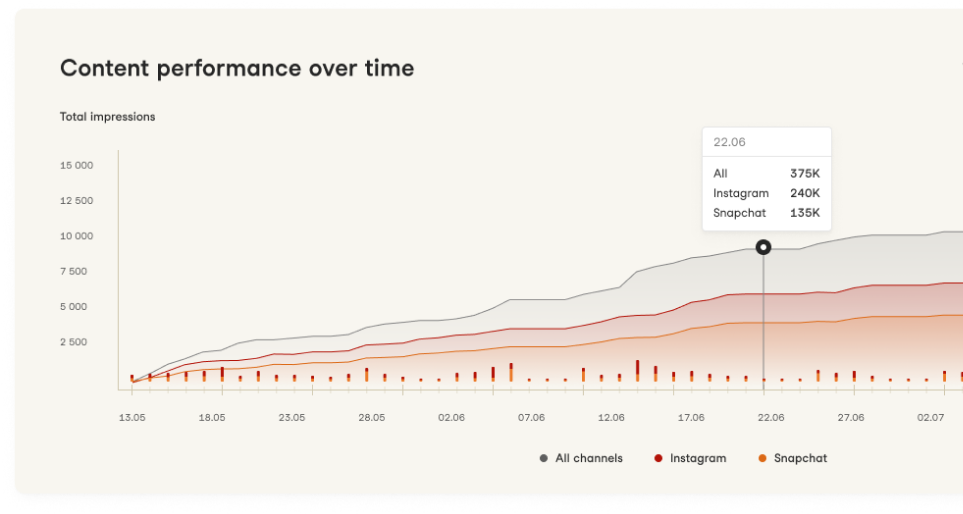
Influencer Marketing Trends to Watch in 2025
Influencer marketing has seen some big changes in recent years, and it shows no signs of slowing down. With new social media features and tech advances, the way we connect with social media platforms and influencers keeps evolving. After more than 20,000 collaborations, we’ve pinpointed key trends that are set to shape influencer marketing in 2025. Here’s what every marketer should keep an eye on to stay ahead.
The shift from images to video
Video content on social media has seen huge growth in recent years, yet many advertisers are only now prioritising video in their influencer campaigns. While video’s importance has been obvious for years, recent data reveals a major shift in focus, with 56% of influencer collaborations now centered on video content, compared to just 2% in 2017. Instagram’s launch of Reels in 2020 was a key driver, and now influencers skilled in video are in high demand. Hootsuite even reports that 85% of advertisers plan to make video a key part of their strategy in 2025, signaling an ongoing, essential focus on video for marketers aiming to maximize engagement.

The growing importance of content amplification
Instagram transitioned from social graph-based recommendations to interest-based discovery a few years ago, which helps emerging influencers reach broader audiences. However, this shift also makes content distribution less predictable, pushing advertisers to invest in paid distribution to secure targeting and reach. Influencers are increasingly concerned with usage rights, as contracts now specify terms around repurposing influencer content. In 2025, we'll see increased budgets for usage rights and paid ads integrated in brands' influencer marketing strategy.
UGC and Influencer content as ad fuel
User-generated content (UGC) has become a backbone of social media, with influencer-led UGC playing an increasingly significant role. On platforms like Meta and TikTok, influencer content consistently outperforms traditional brand-produced content. Meta studies show that ads featuring influencer content experience a 123% lift in awareness and a 53% increase in click-through rates. TikTok also reports a 42% rise in conversions for influencer-made ads. As advertisers recognize the ROI from influencer UGC, we’ll likely see more brands using authentic, influencer-created content in campaigns next year.

Harnessing Social SEO on TikTok
TikTok has quickly become a top search destination, with 23% of users searching for content within 30 seconds of opening the app. This shift is a huge opportunity for "Social SEO," where brands can collaborate with influencers to dominate keyword searches across social media. Some advertisers are just discovering the potential here, but those who invest early in social SEO can gain significant visibility. Our client Haugen-Gruppen saw an 19.3% increase in sales from their TikTok campaign earlier this year, and are still dominating ice cream related keywords on TikTok. SEMrush reported TikTok search is on the rise, highlighting the importance of SEO strategies designed specifically for social platforms.
Digital avatars to remain a niche
Digital avatars, especially synthetic voices, are starting to make their way into the marketing landscape, streamlining production workflows and saving valuable time. However, in the influencer space, avatars are likely to remain a niche. Authenticity and trust are crucial to an influencer's value, and the use of avatars can undermine these qualities. Insider Intelligence anticipates that avatar use will grow in marketing but will complement rather than replace human influencers due to the need for genuine connections in influencer marketing.
Enhanced API capabilities on top Platforms
Top platforms, including Instagram, TikTok, Snapchat, and YouTube, are investing heavily in API advancements, making it easier to extract insights and report on influencer collaborations. This improvement allows for greater campaign optimization and data-driven decision-making, providing brands with the tools to improve their influencer partnerships and achieve better ROI. These enhancements signal a promising trend for marketers who rely on accurate analytics to measure campaign success and adjust strategies in real-time.

Unfiltered, entertaining content at the forefront
Young audiences are drawn to unpolished, entertaining content—especially on TikTok. This trend moves away from the glossy brand aesthetics of the past, with Gen Z favoring raw, relatable messaging. As more brands embrace this style, expect a steady rise in unfiltered, real-time content that connects with audiences through cultural moments, trends, and personal stories, particularly on platforms like TikTok.
YouTube’s resurgence
YouTube is having a renaissance, with influencers rediscovering the platform’s potential for in-depth storytelling. YouTube’s format supports longer, more detailed content, which is valuable for brands wanting to communicate narratives and promote usage of products. Despite the competition from other platforms, YouTube remains a solid choice for brands aiming to create deep and engaging stories in 2025, especially in the Norwegian and Swedish market.
Influencer marketing is at a turning point, with evolving technology and shifting consumer preferences reshaping the field. These trends open up big opportunities for marketers who can adapt quickly. For influencers, the future means mastering video, using Social SEO, and applying a flexible approach to content distribution for the brands they work with. For advertisers, it’s about leveraging these changes strategically and investing in the right content and profiles. Additionally, APIs and data analytics will play a larger role in tracking success and guiding decisions to optimize influencer marketing results.

You may also like

Branded Content vs Native Advertising: What's the Difference?

Dentsu Invests in Influencer Marketing - Becomes inzpire.me Partner
